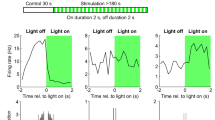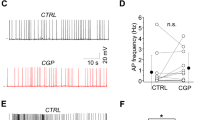Abstract
Neural activity regulates the number and properties of GABAergic synapses in the brain, but the mechanisms underlying these changes are unclear. We found that blocking spike activity globally in developing hippocampal neurons from rats reduced the density of GABAergic terminals as well as the frequency and amplitude of miniature inhibitory postsynaptic currents (mIPSCs). Chronic inactivity later in development led to a reduction in the mIPSC amplitude, without any change in GABAergic synapse density. By contrast, hyperpolarizing or abolishing spike activity in single neurons did not alter GABAergic synaptic inputs. Suppressing activity in individual presynaptic GABAergic neurons also failed to decrease synaptic output. Our results indicate that GABAergic synapses are regulated by the level of activity in surrounding neurons. Notably, we found that the expression of GABAergic plasticity involves changes in the amount of neurotransmitter in individual vesicles.
This is a preview of subscription content, access via your institution
Access options
Subscribe to this journal
Receive 12 print issues and online access
$209.00 per year
only $17.42 per issue
Buy this article
- Purchase on Springer Link
- Instant access to full article PDF
Prices may be subject to local taxes which are calculated during checkout








Similar content being viewed by others
References
Burrone, J. & Murthy, V.N. Synaptic gain control and homeostasis. Curr. Opin. Neurobiol. 13, 560–567 (2003).
Turrigiano, G.G. & Nelson, S.B. Homeostatic plasticity in the developing nervous system. Nat. Rev. Neurosci. 5, 97–107 (2004).
Davis, G.W. & Bezprozvanny, I. Maintaining the stability of neural function: a homeostatic hypothesis. Annu. Rev. Physiol. 63, 847–869 (2001).
Malinow, R. & Malenka, R.C. AMPA receptor trafficking and synaptic plasticity. Annu. Rev. Neurosci. 25, 103–126 (2002).
Burrone, J., O'Byrne, M. & Murthy, V.N. Multiple forms of synaptic plasticity triggered by selective suppression of activity in individual neurons. Nature 420, 414–418 (2002).
Paradis, S., Sweeney, S.T. & Davis, G.W. Homeostatic control of presynapti release is triggered by postsynaptic membrane depolarization. Neuron 30, 737–749 (2001).
Benson, D.L., Isackson, P.J., Hendry, S.H. & Jones, E.G. Expression of glutamic acid decarboxylase mRNA in normal and monocularly deprived cat visual cortex. Brain Res. Mol. Brain Res. 5, 279–287 (1989).
Hendry, S.H. & Jones, E.G. Activity-dependent regulation of GABA expression in the visual cortex of adult monkeys. Neuron 1, 701–712 (1988).
Hensch, T.K. Critical period regulation. Annu. Rev. Neurosci. 27, 549–579 (2004).
Huang, Z.J. et al. BDNF regulates the maturation of inhibition and the critical period of plasticity in mouse visual cortex. Cell 98, 739–755 (1999).
Gianfranceschi, L. et al. Visual cortex is rescued from the effects of dark rearing by overexpression of BDNF. Proc. Natl. Acad. Sci. USA 100, 12486–12491 (2003).
Maffei, A., Nelson, S.B. & Turrigiano, G.G. Selective reconfiguration of layer 4 visual cortical circuitry by visual deprivation. Nat. Neurosci. 7, 1353–1359 (2004).
Morales, B., Choi, S.Y. & Kirkwood, A. Dark rearing alters the development of GABAergic transmission in visual cortex. J. Neurosci. 22, 8084–8090 (2002).
Marty, S., Wehrle, R. & Sotelo, C. Neuronal activity and brain-derived neurotrophic factor regulate the density of inhibitory synapses in organotypic slice cultures of postnatal hippocampus. J. Neurosci. 20, 8087–8095 (2000).
Seil, F.J. & Drake-Baumann, R. Reduced cortical inhibitory synaptogenesis in organotypic cerebellar cultures developing in the absence of neuronal activity. J. Comp. Neurol. 342, 366–377 (1994).
Seil, F.J. & Drake-Baumann, R. TrkB receptor ligands promote activity-dependent inhibitory synaptogenesis. J. Neurosci. 20, 5367–5373 (2000).
Chattopadhyaya, B. et al. Experience and activity-dependent maturation of perisomatic GABAergic innervation in primary visual cortex during a postnatal critical period. J. Neurosci. 24, 9598–9611 (2004).
Rosato-Siri, M., Grandolfo, M. & Ballerini, L. Activity-dependent modulation of GABAergic synapses in developing rat spinal networks in vitro. Eur. J. Neurosci. 16, 2123–2135 (2002).
Rutherford, L.C., DeWan, A., Lauer, H.M. & Turrigiano, G.G. Brain-derived neurotrophic factor mediates the activity-dependent regulation of inhibition in neocortical cultures. J. Neurosci. 17, 4527–4535 (1997).
Kilman, V., van Rossum, M.C. & Turrigiano, G.G. Activity deprivation reduces miniature IPSC amplitude by decreasing the number of postsynaptic GABA(A) receptors clustered at neocortical synapses. J. Neurosci. 22, 1328–1337 (2002).
Bellocchio, E.E., Reimer, R.J., Fremeau, R.T., Jr. & Edwards, R.H. Uptake of glutamate into synaptic vesicles by an inorganic phosphate transporter. Science 289, 957–960 (2000).
Kanaani, J. et al. A combination of three distinct trafficking signals mediates axonal targeting and presynaptic clustering of GAD65. J. Cell Biol. 158, 1229–1238 (2002).
McIntire, S.L., Reimer, R.J., Schuske, K., Edwards, R.H. & Jorgensen, E.M. Identification and characterization of the vesicular GABA transporter. Nature 389, 870–876 (1997).
Chaudhry, F.A. et al. The vesicular GABA transporter, VGAT, localizes to synaptic vesicles in sets of glycinergic as well as GABAergic neurons. J. Neurosci. 18, 9733–9750 (1998).
Owens, D.F., Boyce, L.H., Davis, M.B. & Kriegstein, A.R. Excitatory GABA responses in embryonic and neonatal cortical slices demonstrated by gramicidin perforated-patch recordings and calcium imaging. J. Neurosci. 16, 6414–6423 (1996).
Ebihara, S., Shirato, K., Harata, N. & Akaike, N. Gramicidin-perforated patch recording: GABA response in mammalian neurones with intact intracellular chloride. J. Physiol. (Lond.) 484, 77–86 (1995).
Ben-Ari, Y. Excitatory actions of gaba during development: the nature of the nurture. Nat. Rev. Neurosci. 3, 728–739 (2002).
Sigworth, F.J. The variance of sodium current fluctuations at the node of Ranvier. J. Physiol. (Lond.) 307, 97–129 (1980).
Auger, C. & Marty, A. Heterogeneity of functional synaptic parameters among single release sites. Neuron 19, 139–150 (1997).
Barberis, A., Petrini, E.M. & Cherubini, E. Presynaptic source of quantal size variability at GABAergic synapses in rat hippocampal neurons in culture. Eur. J. Neurosci. 20, 1803–1810 (2004).
Mangan, P.S. et al. Cultured hippocampal pyramidal neurons express two kinds of GABAA receptors. Mol. Pharmacol. 67, 775–788 (2005).
Jones, M.V., Jonas, P., Sahara, Y. & Westbrook, G.L. Microscopic kinetics and energetics distinguish GABAA receptor agonists from antagonists. Biophys. J. 81, 2660–2670 (2001).
Barberis, A., Lu, C., Vicini, S. & Mozrzymas, J.W. Developmental changes of GABA synaptic transient in cerebellar granule cells. Mol. Pharmacol. 67, 1221–1228 (2005).
Otis, T.S., De Koninck, Y. & Mody, I. Lasting potentiation of inhibition is associated with an increased number of gamma-aminobutyric acid type A receptors activated during miniature inhibitory postsynaptic currents. Proc. Natl. Acad. Sci. USA 91, 7698–7702 (1994).
Marty, S., Wehrle, R., Fritschy, J.M. & Sotelo, C. Quantitative effects produced by modifications of neuronal activity on the size of GABAA receptor clusters in hippocampal slice cultures. Eur. J. Neurosci. 20, 427–440 (2004).
Gaiarsa, J.L., Caillard, O. & Ben-Ari, Y. Long-term plasticity at GABAergic and glycinergic synapses: mechanisms and functional significance. Trends Neurosci. 25, 564–570 (2002).
Elmariah, S.B., Crumling, M.A., Parsons, T.D. & Balice-Gordon, R.J. Postsynaptic TrkB-mediated signaling modulates excitatory and inhibitory neurotransmitter receptor clustering at hippocampal synapses. J. Neurosci. 24, 2380–2393 (2004).
Genoud, C., Knott, G.W., Sakata, K., Lu, B. & Welker, E. Altered synapse formation in the adult somatosensory cortex of brain-derived neurotrophic factor heterozygote mice. J. Neurosci. 24, 2394–2400 (2004).
Lu, B. BDNF and activity-dependent synaptic modulation. Learn. Mem. 10, 86–98 (2003).
McLean Bolton, M., Pittman, A.J. & Lo, D.C. Brain-derived neurotrophic factor differentially regulates excitatory and inhibitory synaptic transmission in hippocampal cultures. J. Neurosci. 20, 3221–3232 (2000).
Ohba, S. et al. BDNF locally potentiates GABAergic presynaptic machineries: target-selective circuit inhibition. Cereb. Cortex 15, 291–298 (2005).
Rutherford, L.C., Nelson, S.B. & Turrigiano, G.G. BDNF has opposite effects on the quantal amplitude of pyramidal neuron and interneuron excitatory synapses. Neuron 21, 521–530 (1998).
Vicario-Abejon, C., Owens, D., McKay, R. & Segal, M. Role of neurotrophins in central synapse formation and stabilization. Nat. Rev. Neurosci. 3, 965–974 (2002).
Ernfors, P., Wetmore, C., Olson, L. & Persson, H. Identification of cells in rat brain and peripheral tissues expressing mRNA for members of the nerve growth factor family. Neuron 5, 511–526 (1990).
De Gois, S. et al. Homeostatic scaling of vesicular glutamate and GABA transporter expression in rat neocortical circuits. J. Neurosci. 25, 7121–7133 (2005).
Kittler, J.T. & Moss, S.J. Modulation of GABAA receptor activity by phosphorylation and receptor trafficking: implications for the efficacy of synaptic inhibition. Curr. Opin. Neurobiol. 13, 341–347 (2003).
Li, Z. & Murthy, V.N. Visualizing post-endocytic traffic of synaptic vesicles at hippocampal synapses. Neuron 31, 593–605 (2001).
Xu, X. & Shrager, P. Dependence of axon initial segment formation on Na+ channel expression. J. Neurosci. Res. 79, 428–441 (2005).
Acknowledgements
We thank M. Kinet for help with some of the experiments, and members of our lab for critical discussions. We are grateful to P. Shrager (University of Rochester, Rochester, New York) for the gift of the shRNA plasmids. This work was supported by grants from the US National Institutes of Health, the National Science Foundation, the EJLB Foundation and the Klingenstein Fund.
Author information
Authors and Affiliations
Corresponding author
Ethics declarations
Competing interests
The authors declare no competing financial interests.
Supplementary information
Supplementary Fig. 1
Reduction in GABAergic synapses triggered by chronic suppression also occurs on inhibitory targets. (PDF 2469 kb)
Supplementary Fig. 2
BDNF treatment counters the effects of chronic inactivity. (PDF 1170 kb)
Rights and permissions
About this article
Cite this article
Hartman, K., Pal, S., Burrone, J. et al. Activity-dependent regulation of inhibitory synaptic transmission in hippocampal neurons. Nat Neurosci 9, 642–649 (2006). https://doi.org/10.1038/nn1677
Received:
Accepted:
Published:
Issue Date:
DOI: https://doi.org/10.1038/nn1677
This article is cited by
-
Cortical inhibitory but not excitatory synaptic transmission and circuit refinement are altered after the deletion of NMDA receptors during early development
Scientific Reports (2023)
-
From mechanisms to markers: novel noninvasive EEG proxy markers of the neural excitation and inhibition system in humans
Translational Psychiatry (2022)
-
Endoplasmic reticulum retention and degradation of a mutation in SLC6A1 associated with epilepsy and autism
Molecular Brain (2020)
-
Aberrant expression of S-SCAM causes the loss of GABAergic synapses in hippocampal neurons
Scientific Reports (2020)
-
Molecular, Structural, Functional, and Pharmacological Sites for Vesicular Glutamate Transporter Regulation
Molecular Neurobiology (2020)



